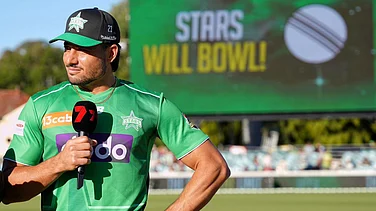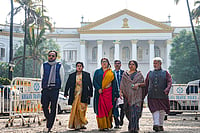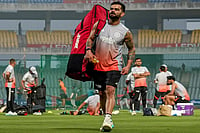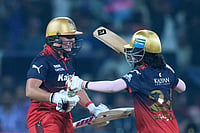Allow me, if you would, the opportunity to share my "dream team" for the final with you. My selection will no doubt be open to conjecture. However, I have outlined my reasons for the players' selection in the team and hope that this creates a "match" which has all the promise and potential to be as exciting for you as it is for me.
The playing conditions in the countries hosting the 1996 World Cup, India, Sri Lanka and Pakistan, needed to be taken into account. In particular, pitch conditions, low bounce, front foot batting, bowlers with variation, spin and accurate pace needed to be considered.
The team I have selected is based on experience, form, skill, potential and balance.
One-Day World XI Team:
1. Mike Atherton—England (Captain)
2. Sachin Tendulkar—India
3. Brian Lara—West Indies
4. Steve Waugh—Australia
5. Arjuna Ranatunga—Sri Lanka
6. Ian Healy—Australia
7. Shane Warne—Australia (wicket keeper)
8. Wasim Akram—Pakistan
9. Waqar Younis—Pakistan
10. Fanie de Villiers—South Africa
11. Craig McDermott—Australia
Mike Atherton:A right-handed batsman who has proven that the weight of captaincy does not mean a diminished batting performance. He can be regularly relied upon to anchor an innings by occupying the crease and batting for a long time.
Atherton's magnificent 185 in the second Test against South Africa at Johannesburg in December 1995, which salvaged a draw for England, demonstrated his tenacity and his high levels of concentration and technical ability.
In a one-day side, it is important to have a player like Atherton, who is a solid, reliable performer, allowing the stroke makers to play around him.
Sachin Tendulkar: Tendulkar is an attacking, master batsman who demonstrates excellent control in his wonderful, cultured stroke play. He can completely demoralise a bowling attack, often coming down the wicket ambitiously and confidently wanting to hit fast bowlers back over their head, or through the cover area.
In sub-continent conditions, his handy slow medium-paced deliveries, where the ball keeps low and doesn't come onto the bat, makes him a handy change bowler.
Brian Lara: Lara holds the world record for the most runs scored in a Test innings (375) and in first class cricket (501). Although he withdrew from the West Indies team for their tour of Australia at the end of 1995, he is quite clearly still the world's premier batsman. He is an innovative, confident, destructive player in form who can adapt to any conditions. Being a left-handed batsman, he provides a nice contrast to the two right-handed opening batsmen and if the bowlers are unable to adapt and change their line to Lara, he will destroy them with exquisite stroke play all around the wicket.
Steve Waugh: One of the most improved players in world cricket. In one-day cricket I would class him as a genuine all-rounder, who bats sensibly, soundly and with confidence. His fielding close to the wicket, in the gully or at backward point, is superb and his often direct hits or accurate throws back to the wickets for run outs make him a specialist fielder. Waugh's medium-pace bowling is more than useful, but his greatest strength is his ability to change pace, with his slower ball achieving some success when bowled "at the death". He is a player who accepts responsibility and therefore is a very valuable all-round member of any team.
Arjuna Ranatunga: A very experienced player, though many would be surprised at his selection. I consider him one of the best middle-order, one day batsmen. He is a left-hander, which gives him an advantage. He is what I call a "run a ball man", often deflecting the ball off his pads behind square on the leg side, but also opening the face of the bat and running the ball to backward point and third man for easy singles. If he scores 50 or 60 runs at a later stage of an innings, he would generally have faced the same number of balls or less. Although he doesn't bowl much these days, Ranatunga can bowl gentle-pacers, if necessary.
Ian Healy : Healy is my choice for wicket keeper because of his proven ability to keep wickets efficiently to both pace and spin. His play is often brilliant, but it is his constant reliability and steadiness which are his strengths. With the inclusion of Warne as a spin bowler, it is essential to include Healy because of his ability to read Warne. I would class him as an all-rounder in one day cricket. His batting is more than handy. He can score quickly, with the ability to hit boundaries in the later stages of an innings.
Shane Warne: Without doubt, Warne is the world's best spin bowler and has proven to be the nemesis of many great batsmen with his wonderful ability to baffle and bemuse them in any sort of condi-tions. He is an attacking bowler who will get wickets, both by frustrating batsmen and by genuinely dismissing them. His ability to control and vary the flight of the ball is quite extraordinary and wonderful to watch. As a batsman, he can score useful runs.
Wasim Akram: Akram, a left-arm fast bowler, has the devastating ability to achieve excessively sharp movement off both the pitch and in the air. His inswinging yorker is difficult to handle and dismisses many batsmen. He is difficult to score off as he is generally very accurate with the ball, often dismissing batsmen early on. Later in an innings, he is still a threat and a partnership breaker. His variation includes bowling around the wicket, which is unusual for a left-arm bowler and more difficult for batsmen to face and adjust to. Akram is a big hitter of the ball and can turn a match with an inspired individual performance.
Waqar Younis: Younis, in tandem with Akram, provide the most potent pace bowling attack in world cricket today, complementing each other quite superbly. Younis appears to bowl better later in the innings, and with the older ball he has cultivated the reverse swing theory, his greatest asset, to devastating effect. It would not be uncommon for him to pick up three wickets in as many overs and thus destroy any chance a batting team may have of victory. His batting is handy and he could make a useful 20 when it matters.
Fanie De Villiers: In my opinion, De Villiers is the best one-day bowler in world cricket. His accuracy and control are quite superb and his ability to concede on average only three runs an over throughout his one-day international career, is quite outstanding. He is the type of bowler who may get 0 for 30, but that contribution is essential in containing the opposition and restricting them to a low score.
Craig McDermott: McDermott is an aggressive new ball bowler, who bowls a magnificent outswinger which is likely to dismiss a bats-man, caught by the keeper or in the slips. He is generally demanding in his line and length and is a partnership breaker in other spells. As a batsman, he can be promoted in the order either to try and hit the spinners out of the attack or to hit quick boundaries. His throwing arm from the deep is fast and accurate and is respected by players world-wide.
This "Dream Team" has been more difficult to finalise than I originally thought. At the expense of omitting a fast bowler, I was tempted to include another spin bowler for sub-continental conditions, by adding Anil Kumble who could have complemented Warne.
I leave the selection of the "opposing dream team finalists" up to the readers. However, if I were to select the team, I would certainly consider the following players. My World One-Day International "Dream Team Opposition XI":
1. Mark Waugh—Australia
2. Mark Taylor—Australia
3. Aravinda de Silva—Sri Lanka
4. Mohammed Azharuddin—India (Captain)
5. Hansie Cronje—South Africa
6. Hashan Tillekaratne—Sri Lanka (wicket keeper)
7. Anil Kumble—India
8. Chaminda Vaas—Sri Lanka
9. Courtney Walsh—West Indies
10. Curtly Ambrose—West Indies
11. Alan Donald—South Africa.






















.png?w=200&auto=format%2Ccompress&fit=max)



